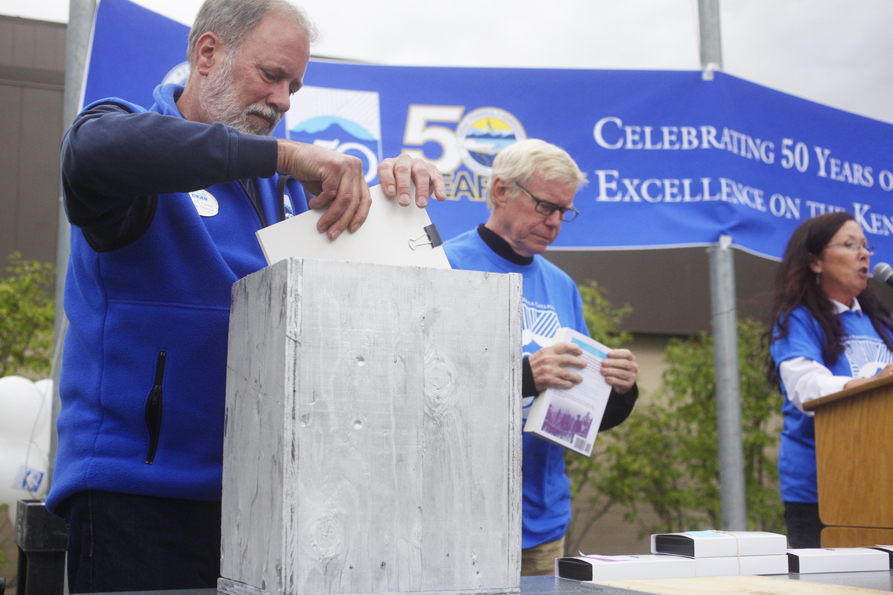At a big party on Aug. 14, three civic entities that form the backbone of the Kenai Peninsula celebrated 50 years: the Kenai Peninsula Borough, the Kenai Peninsula Borough School District and Kenai Peninsula College.
Held at KPC’s Kenai River Campus, the event included a barbecue, release of a history book about the college and a reading of a list of items to go into a time capsule, to be reopened in 2064.
The borough and school district got their start out of frustration by the state when the Kenai Peninsula, Anchorage and the Matanuska-Susitna River Valley areas couldn’t agree to form boroughs.
“(They) couldn’t get the job done, so the state formed the boroughs for them,” said borough assembly member Brent Johnson, Clam Gulch, former president of the Kenai Peninsula Historical Association. “What the state did was take voter Districts 9 and 10 and grouped it together to form the Kenai Peninsula Borough.”
According to a timeline by former KPB Mayor David Carey, several citizen committees had met from 1961 to 1963 about how to form a borough — or boroughs. Some wanted a Homer Borough, like Arlene Kranich of Homer. In April 1963, the Alaska Legislature passed and Gov. Bill Egan signed a bill saying that on Jan. 1, 1964, a borough would be formed.
In May 1963, Kenai citizens filed a petition to create a first-class borough to include Kenai, North Kenai (Nikiski), Solodtna, Sterling, Kasilof and Tustumena. Homer citizens also started a petition for a lower peninsula borough, but both petitions were rejected by the Local Boundary Commission for a lack of signatures.
“That sort of disheartened the people who were trying to form a peninsula-wide borough,” Johnson said of those efforts. “There were some who didn’t want a borough and thought they could stop the process.”
A call was made for a vote on Dec. 3, 1963, to decide if the borough should be a first-class or second-class borough, if it should have a borough chairman form of government, who would be the borough chairman, who would be at-large assembly members and who would be school district members. Frank Mullen Sr. hired the late Sen. Ted Stevens, then an Anchorage lawyer, to try to get an injunction stopping the election, but it was denied.
The voters decided to form a second-class borough and elected Harold Pomeroy of Bear Cove as assembly chairman. It also elected at-large assembly and school district board members (see list, this page).
The school board came into effect in January 1964, with Edward Hollier elected as chairperson. On Jan. 23 the board hired Dr. Carl Wagner as the first superintendent.
On Jan. 4, 1964, the assembly first met. With at-large members, the assembly also included appointed members made up of council members from Kenai, Seldovia and Seward. Johnson said some cities had multiple assembly members, some elected and some appointed, with not every member having one vote. Voting was weighted, a complicated system.
“You’d see results like ‘42.7 to 90,’” Johnson said.
Lou Collier of Seldovia is one of the last living members of that first assembly. Collier, 84, came to Seldovia in 1948, and was on the Seldovia City Council.
“None of us knew what the heck a borough was,” Collier said. “There really was no agenda. It was just a discussion of what we were supposed to do. … The first order of business was ‘How are we going to raise money to accomplish the task of what we were going to do?’”
The assembly decided a real property tax would be the way to go, Collier said — but not a property tax on things like cars and boats.
“We all agreed, all of us wholeheartedly, that there would never be a personal property tax. That was unanimous,” Collier said.
Local school boards existed before the borough. Pegge Erkeneff, a school district spokesperson, noted that the territorial Bureau of Education operated the Hope School from 1902 to 1922. The Hope School was closed 1923-1932 and 1957-1970.
In the 1963-64 school year, the enrollment for grades K-12 was 2,696. Now it’s 8,709 students, an example of borough changes.
At the 50th anniversary party, KPB Mayor Mike Navarre noted that progress. He also read a list of all the borough mayors, including his father, George Navarre, the second mayor.
“The reality is no government could succeed without the community. This is really your government,” Navarre said.
Michael Armstrong can be reached at michael.armstrong@homernews.com. Kelly Sullivan of Morris News Service-Alaska, Peninsula Clarion, contributed to this story.
Kenai Peninsula Borough History
(from a timeline by former KPB Mayor David Carey)
1961:
Gov. Bill Egan signs a bill allowing for the creation of boroughs.
Feb. 1961:
The League of Kenai Peninsula Chambers of Commerce meet in Homer to consider creating a Kenai Peninsula Borough.
April 1963:
Borough formation meetings are held in Ninilchik, Homer, Anchor Point and Soldotna. Gov. Egan signs a bill directing that on Jan. 1, 1964, a borough be formed.
Dec. 3, 1963:
Voters choose to create the Kenai Peninsula Borough and make it a second-class borough. Harold Pomeroy is elected as borough chairman, with borough members Jack Randall, Cooper Landing; Morris Coursen, Sterling; Robert Williams. Anchor Point, and Robert Kranich, Homer, elected as at-large members.Joining the at-large members are three members selected by city councils: Richard Morgan, Kenai; William Vincent, Seward; and Lou Collier, Seldovia.
Elected to the school board are Anna Wade Jackinsky, Edward Hollier, Edward Rehder, Jesse Robinson and Robert Cousart.


